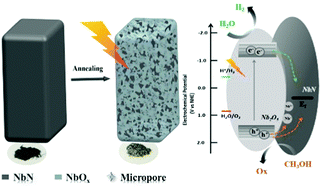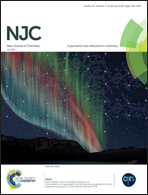In situ formation of NbOx@NbN microcomposites: seeking potential in photocatalytic and Li-ion battery applications†
Abstract
NbOx@NbN microcomposite particles with enhanced photocatalytic and electrochemical properties were synthesized through in situ partial oxidation from a NbN precursor by annealing in air. Thermal treatment optimization is carried out accompanied by extensive investigation on the formation of NbOx with TEM and XPS analysis. The as-prepared NbOx@NbN composite inherited the layer-like structure from the pre-annealed NbN powders and grew with mixed niobium oxides. The sample exhibited a 17-fold increase in photocatalytic hydrogen production and a 1.8 times enhancement of the specific capacity as an anode material for lithium-ion batteries compared with commercial Nb2O5. An illustrative scheme of the sample formation and photo-driven reaction was proposed. Due to the escape of nitrogen during heating, the mesopore-containing microstructure and increased specific surface areas are advantageous for electron mobility and interfacial reactions. By analyzing the positive effect of the optical and electrical properties from NbOx and the improved light absorption from the presence of NbN, the functional properties of the NbOx@NbN heterostructure in terms of both photocatalytic and electrochemical applications are revealed for the first time.



 Please wait while we load your content...
Please wait while we load your content...